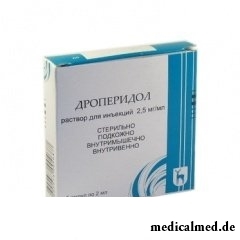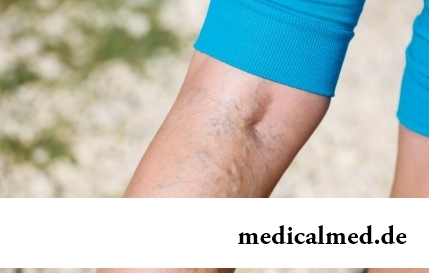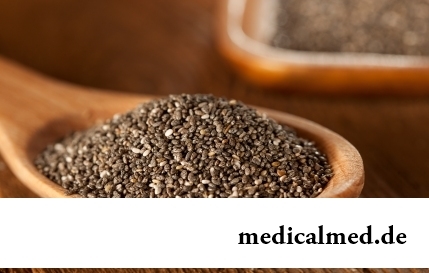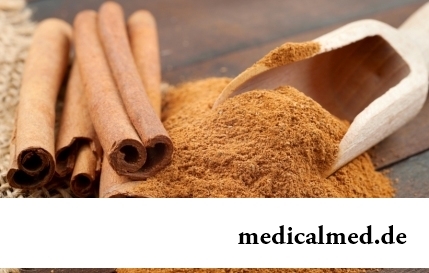





Droperidolum
Application instruction:
 Droperidolum – drug with antiemetic, antipsychotic and antishock action.
Droperidolum – drug with antiemetic, antipsychotic and antishock action.
Form of release and structure
Droperidolum is released in the form of solution for injections (in ampoules on 2 or 5 ml, on 5 or 10 ampoules in a cardboard pack, or on 5 ampoules in blister strip packagings, on 1, 2, 20, 30, 50, 100 packagings in a cardboard pack; on 5 or 10 ml in bottles, on 5 bottles in blister strip packagings, on 30 or 50 packagings in a cardboard pack).
Active agent is a part of 1 ml of solution: Droperidolum – 2,5 mg.
Indications to use
- Surgery: introduction anesthesia, premedication, potentiation of the general and regional anesthesia; a neuroleptanalgesia (along with fentanyl); providing sedation, elimination of vomiting and pain in the postoperative period, vomitings and nausea during surgical and diagnostic manipulations;
- Therapy: shock and pain at injuries, heavy attacks of stenocardia, a myocardial infarction, hypertensive crisis, a fluid lungs;
- Psychiatric practice: hallucinations, psychomotor excitement.
Contraindications
- Coma;
- Extrapyramidal disturbances;
- Increase in an interval of QT at an ECG;
- Heavy depression;
- Hypopotassemia;
- Cesarean section;
- Arterial hypotension;
- Age up to 2 years;
- Hypersensitivity to components of drug and derivatives of morphine.
Use of Droperidolum by pregnant women perhaps only in cases when the estimated advantage for health of mother is higher than potential risk for a fruit. In case of need drug uses by women during a lactation breastfeeding need to be stopped.
Route of administration and dosage
The dose of Droperidolum is defined individually, considering the nature of a disease, age, the general physical state, body weight used at the same time drugs, a type of the forthcoming anesthesia.
The adult for premedication in 15-45 minutes prior to the beginning of surgical intervention intramusculary enter 2,5-5 mg of Droperidolum, to children – at the rate of 100 mkg/kg.
The adult for introduction to anesthesia drug appoint in a dose 15-20 mg (intravenously). To children perhaps intravenous (in a dose of 200-400 mkg/kg) or intramuscular (in a dose of 300-600 mkg/kg) introduction.
For maintenance of anesthesia at long operations perhaps repeated intravenous administration of Droperidolum in a dose of 2,5-5 mg.
During the postoperative period the adult each 6 hours are appointed intramusculary on 2,5-5 mg.
Side effects
At use of Droperidolum development of disturbances from some systems of an organism is possible:
- Central nervous system: drowsiness, a dysphoria in the postoperative period and, on the contrary, at use of the raised doses – fear, motor excitability, concern; seldom – extrapyramidal symptoms; in some cases in the postoperative period – a depression, hallucinations;
- Cardiovascular system: tachycardia and moderate arterial hypotension (usually special therapy is not required); seldom or never – arterial hypertension (it is the most probable – at the combined use with fentanyl or other analgetics entered parenterally);
- Alimentary system: dispepsichesky phenomena, appetite loss, nausea; seldom – tranzitorny abnormal liver functions, jaundice;
- Allergic reactions: seldom – dizziness, anaphylactic reactions, a shiver, a bronchospasm, a laryngospasm.
Special instructions
Droperidolum should be applied only in stationary conditions.
It is necessary to appoint drug with care the patient with functional disturbances of kidneys and a liver, a depression, epilepsy, and also at the states preceding an epileptic seizure.
At a pheochromocytoma after introduction of Droperidolum tachycardia and heavy arterial hypertension can develop.
During therapy it is necessary to expect a possibility of development of the expressed arterial hypotension. Also drug can cause pressure decline in a pulmonary artery that needs to be considered during diagnostic and surgical procedures. The patients receiving Droperidolum need careful medical control.
The initial dose of drug should be reduced to the patients of advanced age exhausted and physically weakened by the patient. At increase in a dose it is necessary to be guided by the gained effect.
It is necessary to appoint Droperidolum in a smaller dose at simultaneous use with the medicines exerting the oppressing impact on the central nervous system. Respectively, after Droperidolum of a dose of such drugs also reduce.
Use of Droperidolum in the raised doses (25 mg and more) can lead to the sudden death of patients with disturbances of a cordial rhythm against the background of alcoholic abstinence, a hypoxia or disturbances of electrolytic balance.
In surgical practice at use of drug it is necessary to control parameters of a physiological condition of an organism carefully. When carrying out peridural or spinal anesthesia development of blockade of a sympathetic nervous system and intercostal nerves is possible that, in turn, can lead to breath difficulty, development of arterial hypotension and expansion of peripheral vessels.
To avoid developing of orthostatic hypotension it is recommended to be careful when transporting the patient, to avoid a sharp postural change of a body.
Against the background of action of Droperidolum and within 24 hours after its use it is necessary to avoid performance of potentially dangerous works demanding bystry psychomotor reactions and high concentration of attention.
Medicinal interaction
At simultaneous use of Droperidolum with some medicines there can be undesirable effects:
- The drugs exerting the oppressing impact on the central nervous system (derivatives of benzodiazepine, anesthetic, opioid analgetics, hypnagogues): strengthening of the oppressing influence on the central nervous system;
- Anti-hypertensive drugs: potentiation of their action;
- Epinephrinum and others adreno-and sympathomimetic means: manifestation in their relation of antagonism;
- Dopamine agonists, including Bromocriptinum, лизурид and a levodopa: inhibition of their action.
Terms and storage conditions
To store in protected from light, the place, dry, unavailable to children, at a temperature up to 20 °C.
Period of validity – 5 years.
According to WHO researches the daily half-hour conversation by the mobile phone increases probability of development of a tumor of a brain by 40%.

For the person who daily since morning gathers for work it is very important to wake up vigorous and ready by day of work. On most...
Section: Articles about health
Small appetite at the child – the complaint which pediatricians should hear practically from each mother. Most often it is carried to the category of children's whims, however the refusal of food in certain cases can be to alarming symptoms therefore it cannot be ignored....
Section: Articles about health
All the known slogan "Protect Men!" arose not from scratch. In a sense, the nature created men much less adapted for vital disorders, than it seems at first sight. Statistically, men are ill more often, than women, have the majority of illnesses heavier and earlier die. The situation is aggravated with the fact that our fathers, husbands, brothers and sons are not always inclined to care for the health. Partly it happens because of unwillingness of t...
Section: Articles about health
On health of the person physicians know about salutary action of animals long ago. About 7 thousand years ago great Hippocrates рекоменд...
Section: Articles about health
The modern person not always manages to find housing in the environmentally friendly region and such work which would not do harm to health. With food stuffs at first sight the situation is much better: shops are overflowed with goods which are positioned пр...
Section: Articles about health
The varicosity has familiarly many, statistically, this disease more than a half of all adult population. As a rule, the varicosis affects preferential superficial vessels, and is shown by characteristic cosmetic defects. The deep vein thrombosis as this illness at the initial stages can imperceptibly proceed is represented much more dangerous, and in the started cases threatens with serious danger – thrombosis. This state, when the blood clot formed...
Section: Articles about health
Statistically cystitis 25-30% of women up to 40 years have. With age this indicator raises, besides many do not get in to become...
Section: Articles about health
For the last decades the diabetes mellitus of the second type became really world problem. The number of cases annually increases, and average age of patients for whom the illness is diagnosed, steadily decreases. Specialists consider that one of osno...
Section: Articles about health
According to data of World Health Organization, the cataract is diagnosed almost for 7% of the population of Earth. The statistics of incidence is considered not full as at an initial stage the illness, as a rule, does not cause to the person of special inconveniences, and many diseased sees doctors not at once. The cataract is not only one of the most widespread ophthalmologic illnesses, but also the reason of a half of cases of loss of sight....
Section: Articles about health
Very often as a source of the infection which caused a disease serves our house - the place which a priori has to be safe. However...
Section: Articles about health
Venereal diseases in medicine are called the infections which are transmitted preferential sexually, now they and are called - infections, sexually transmitted, or STD. Among them is also life-threatening. In spite of the fact that majority...
Section: Articles about health
Quite large number of people adheres to the principles of vegetarian food. But how to be if in a family of vegetarians there are children? Whether it is possible to eat also it the same as to parents, or after all the children's organism is not adapted for the use of exclusively vegetable food? Let's try to understand....
Section: Articles about health
To look healthy and means well-groomed not only to be pleasant to people around, but also to feel strong, sure and taken place. To Spa...
Section: Articles about health
The winter swimming in open reservoirs called in our country by "winter swimming" – officially recognized sport and one of the most extreme ways of a hardening of an organism. This occupation has an old story and adherents in many countries. Are annually carried out...
Section: Articles about health
No, probably, the person who would not have cold. Cold, cough, a headache – these symptoms are known to everyone. The peak of catarrhal diseases is the share of fall. SARS already came to schools and kindergartens, flu slowly makes the way to the cities, in a word, winter close!...
Section: Articles about health
The chia plant, or the Spanish sage, is from South America. The indigenous people of the continent since ancient times used in food it семена:...
Section: Articles about health
What is in our understanding weeds? It plants which are considered to be suitable only for compost pits and feeding of animals. Meanwhile, among the weeds growing literally under legs it is possible to find the mass of the officinal herbs possessing invaluable Paul...
Section: Articles about health
The summer of this year in Russia was very ambiguous. Regions suffered from a merciless heat, from pouring rains, the hail from time to time dropped out, then there was again a heat which alternated with rainfall again. Many people suffer from such sharp changes of weather. Even flu epidemics and a SARS were recorded....
Section: Articles about health
The kid who was recently born is surrounded with love of adult family members and their cares without which the baby cannot exist....
Section: Articles about health
Ayurveda - the most ancient tselitelsky practice which came to us from India. It represents the doctrine about maintenance of physical, psychological and moral health of the person by means of the complex of procedures including a diet, cleaning of an organism, respiratory упр...
Section: Articles about health
Turnip, radish, horse-radish – once these and other products enjoyed wide popularity at our ancestors, being not only the food sating an organism but also the medicines curing of many diseases. Unfortunately, the use of some of them got out of fashion long ago, and once favourite plants and vegetables almost ceased to make a contribution to human health. Inclusion of such products in a modern diet − an effective measure of prevention and treatment of diseases which seldom suffered...
Section: Articles about health
During foot walks blood moves on vessels more actively and one and all bodies are supplied with a large amount of oxygen. N...
Section: Slideshow
Phobia – the persuasive fear of a certain contents shown in a specific situation against the will of the person. Concepts of a phobia and fear are similar, however if the fear is natural protective function of mentality, then the phobia is its deviation. So the person can an ispytyva...
Section: Articles about health
Condition of lips (their morbidity, outward) – one of indicators of health of the person. The peeling, dryness, pallor, and also cracks in corners of a mouth can be not only the cosmetic shortcoming which arose owing to physical damages and weather conditions but also the satellite of some diseases and disturbances in an organism needing treatment. Let's consider 10 possible reasons of emergence of angular cracks (perleches) in corners of a mouth and ways of their elimination....
Section: Articles about health
Each person knows that fervescence is an illness sign. However about existence of diseases can to suite...
Section: Articles about health
The medicine promptly develops, and the fact that else quite recently it seemed by miracle can now. We are not surprised any more to the fact that people with artificial joints and extremities can play sports, organ transplantation became a routine, and the latest cancer medicine п...
Section: Articles about health
The climax, or menopause is the normal process of the termination of genital function of the woman which is followed by serious hormonal changes in an organism. Usually the menopause begins at the age of 50-55 years, but characteristics of this process are very individual. Factors of earlier approach of a climax are irregular sex life, numerous abortions, addictions, existence of endocrine, autoimmune and gynecologic diseases, frequent stresses and excessive hobby of diets...
Section: Articles about health
